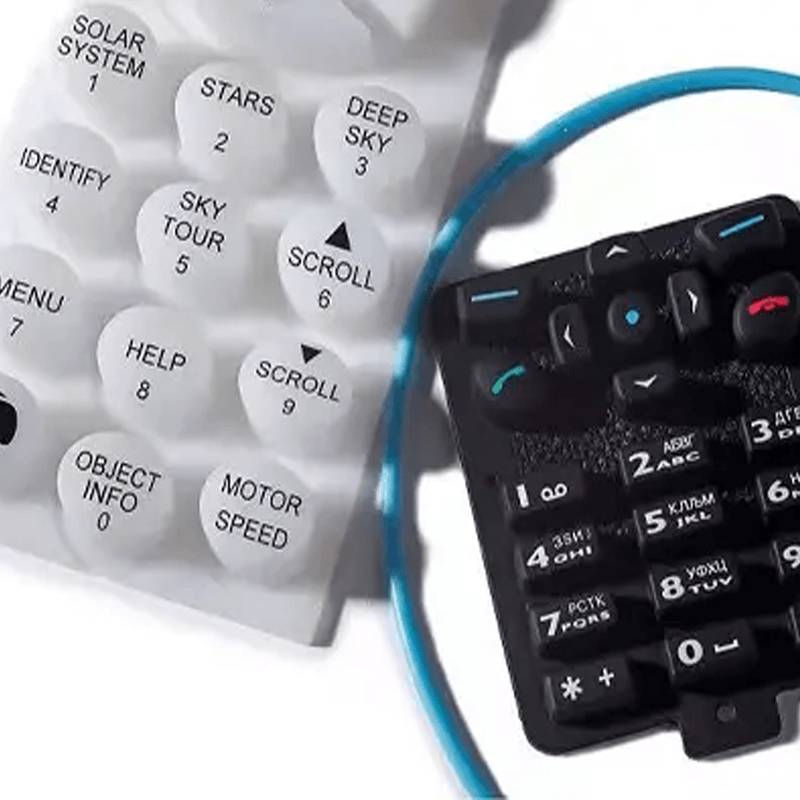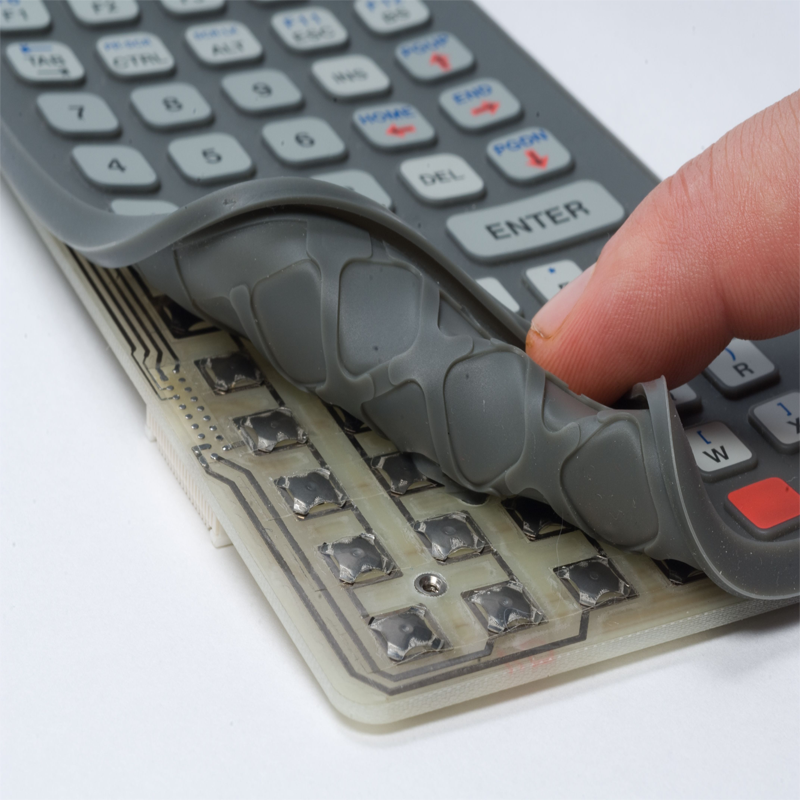At Rockeyapd, we understand that delivering high-performing, reliable silicone rubber keyboards is essential across diverse sectors, including industrial machinery, consumer electronics, and medical devices. Our commitment to quality is embodied in a rigorous and multi-stage testing process designed to uphold stringent performance standards. Through these meticulous evaluations, we ensure that every keyboard we produce excels in precision, responsiveness, durability, and environmental resilience, meeting the varied demands of our clients with consistency and reliability.
In this article, we’ll provide an overview of our comprehensive testing procedures that verify the precision and durability of each silicone rubber keyboard. These procedures cover critical factors such as dimensional accuracy, actuation response, electrical conductivity, longevity, surface resilience, and environmental resistance.
-
Dimensional Precision and Fit Evaluation
Ensuring that each component of our silicone rubber keyboards meets precise dimensional specifications is fundamental to our testing process. This first step guarantees that every keyboard will seamlessly integrate with its intended application, minimizing any potential compatibility issues.
Testing Methodology:
We employ high-precision digital calipers, micrometers, and laser measurement tools to meticulously measure the length, width, and thickness of individual keys and the overall keyboard layout. Additionally, we examine the alignment and spacing of each key to ensure consistency and adherence to client specifications.
![]()
Standards Compliance:
Where customer-specific tolerances are not provided, we reference international standards, including ISO 3302-M2, for acceptable rubber product tolerances. This adherence ensures each keyboard meets high standards of dimensional accuracy, enabling flawless fit and compatibility within the application’s system.
-
Actuation Force and Tactile Feedback Assessment
The actuation force is a defining characteristic that impacts the user’s tactile experience with silicone rubber keyboards. Optimal actuation force enhances the user experience, preventing the keyboard from feeling overly stiff or too sensitive to accidental keystrokes.
Testing Methodology:
To assess actuation force, we use sophisticated testing machines that apply precise pressure to each key, recording the force needed to activate it. This process confirms that each key’s actuation force is within the specified range, ensuring a comfortable and reliable user experience.
Industry Standards:
Our force testing adheres to established industry standards across different applications, with ranges tailored for various use cases:
– Light-touch keys: 20g ± 20-25g
– Medium-force keys: 100g ± 15-20g
– Heavy-duty keys: 150g ± 20-25g
– Extra-heavy-duty keys: 200-300g ± 50g
By calibrating these levels based on client requirements, we provide the optimal tactile feedback for applications, whether for consumer products, medical equipment, or industrial devices.
![]()
-
Electrical Contact Resistance Testing
For silicone rubber keyboards, electrical performance hinges on the conductive properties of the keys. Low contact resistance is crucial for reliable signal transmission and overall keyboard functionality.
Testing Methodology:
To evaluate contact resistance, we use advanced digital multimeters (avometers) that measure resistance across the keyboard’s conductive elements, which may include carbon pills or conductive inks. Each resistance measurement is held to strict thresholds to guarantee efficient signal transmission with each key press.
Standard Resistance Values:
Our testing ensures each keyboard’s resistance values meet these benchmarks:
– Carbon pill resistance: Less than 100 ohms
– Transfer-printed conductive ink: Less than 2500 ohms
– Silkscreen-printed conductive ink: Less than 500 ohms
These specifications are essential for applications where consistent signal delivery is critical, such as medical devices or precision-driven machinery.
-
Key Durability and Longevity Testing
Durability testing is integral for keyboards expected to withstand high-frequency usage without compromising performance. Our key lifetime testing simulates extended use to ensure that the keys maintain both functional and visual integrity over time.
Testing Methodology:
Using automated equipment, we apply continuous, uniform pressure to simulate prolonged usage. This accelerated wear testing assesses the resilience of both the rubber membrane and the conductive materials under repetitive strain.

Test Parameters:
– 100,000 Presses: No visible signs of deformation or damage in the rubber components.
– 200,000 Presses: Conductive elements remain fully intact with no detachment or degradation.
The testing machine operates at a frequency of 2-5 presses per second, ensuring each keyboard undergoes a realistic, high-stress evaluation to determine its long-term reliability.
-
Surface Abrasion and Wear Resistance Analysis
Surface resilience is essential for silicone rubber keyboards that may endure extensive use and exposure to abrasive forces. This test ensures that the keyboard’s surface and key legends remain intact, even under frequent use in demanding environments.
Testing Methodology:
We use an alcohol abrasion testing machine that replicates the wear caused by regular usage and cleaning. Each key undergoes a 100-cycle abrasion test where an isopropyl alcohol-soaked cloth is passed over the surface with a 500g load at a speed of 1.5 rotations per second.
![]()
Testing Requirements:
To pass this assessment, key legends must remain clearly visible, and surface wear should be minimal. This standard guarantees that our keyboards retain their appearance and functionality over an extended period, even when exposed to frequent cleaning or contact with environmental elements.
-
Environmental and Chemical Resistance Testing
Silicone rubber keyboards often function in challenging environments with varying temperatures, humidity levels, and exposure to chemicals. Environmental and chemical resistance testing is crucial to ensure our keyboards perform reliably under such conditions.
Testing Methodology:
Using environmental chambers and chemical resistance stations, we expose keyboards to temperature ranges from -40°C to +120°C and subject them to a variety of chemicals, including oils, solvents, and cleaning agents. Following exposure, we assess the keyboard’s flexibility, conductivity, and overall functionality to confirm resilience against environmental stressors.
Equipment and Conditions:
Our environmental chambers simulate extreme temperature and humidity levels, while chemical resistance stations allow us to test the keyboards’ tolerance to industrial-grade chemicals. This process ensures that each keyboard maintains its functional and structural integrity, even under harsh conditions.

Final Thoughts
At Rockeyapd, we take pride in our robust testing framework, which guarantees that each silicone rubber keyboard meets the highest standards of performance, quality, and reliability. Our use of advanced testing equipment and adherence to rigorous industry standards enables us to deliver products that consistently meet the specific needs of our clients across various industries. From dimensional accuracy to durability under demanding conditions, every aspect of our testing process is meticulously designed to ensure optimal performance.
Our commitment to excellence extends to continual investment in new testing technologies and process improvements, helping us maintain our role as a trusted supplier of high-quality silicone rubber keyboards. Whether for industrial machinery, medical devices, or consumer electronics, we provide precision-engineered keyboards that combine reliability, durability, and aesthetic appeal.
If you’re looking to enhance your project with high-performance silicone rubber keyboards, reach out to Rockeyapd today. Our team is here to support you in creating products that deliver excellence in every keystroke.
